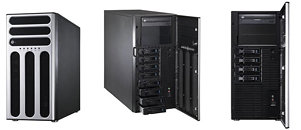Thursday, June 11th 2009

ASUS Introduces TS700-E6 and TS500-E6 Servers and Workstations
ASUS, the leading producer of servers and workstations, recently announced the availability of its latest 5U pedestal and rack-mountable servers and workstations-the ASUS TS700-E6/RS8 and TS500-E6/PS4. Both are based on Dual and Quad-Core Intel Xeon Processor 5500 series platforms with DDR3 memory and PCIe 2.0 support. They also feature additional expansion slots which can also be used for a dedicated graphics card, a MIO network card and other expansion options for personal workstation use-providing customers with high flexibility, reliability, storage capacity and expandability.Space-saving and Advanced System Architecture with Versatile Expandability
Both pedestal and rack-mountable for, the ASUS TS700-E6/RS8 and TS500-E6/PS4 support the latest Intel Xeon Processor 5500 series with Intel Core Microarchitecture Platform for awe-inspiring performance and faster processing speeds. The ASUS TS700-E6/RS8 features 12 DIMM slots that support up to 96GB (RDIMM) DDR3 memory, while the ASUS TS500-E6/PS4 features 6 DIMM slots that support up to 48GB (RDIMM) DDR3 memory. Both systems are designed to cope with the demands of processor-intensive applications, as well as extensive multitasking. The use of DDR3 memory enables a significantly higher processing speed and lower power consumption. What differentiates these two systems from mainstream rack servers is the expandability that they provide to the user. The ASUS TS700-E6/RS8 features 6 expansion slots. In workstation mode, it hosts one PCI-E x16 (x16 link), two PCI-E x16 (x8 link) and two PCI-X 100/133MHz slots. In server mode, it offers four PCI-E x16 (x8 link) and two PCI-X 100/133MHz slots. Flex-E technology transforms the ASUS TS700-E6/RS8 into a dual-purpose server. With a PCI Express x16 (x16 link) slot that automatically switches to a x8 link in the event that its PCI Express x8 (x8 link) on slot five is occupied, the ASUS TS700-E6/RS8 allows users to enjoy ease-of-use when switching between server and workstation modes.
The ASUS TS500-E6/PS4 features one PCI-E x16 (x16 link) that supports professional graphics cards, two PCI-E x8 (x4 link) slots and one PCI 32-bit/33MHz slot for uncompromised versatility and performance.
VGA and MIO Card Support for Workstation Use
With a built-in PCI-E x16 (x16 link) expansion slot, the ASUS TS700-E6/RS8 and TS500-E6/PS4 are capable of supporting professional graphics cards for workstation use; while the optional MIO audio card offers excellent sound quality to complement the robust graphics power for workstation users-offering an enhanced signal-to-noise ratio and 7.1 virtual surround for the most exhilarating surround sound in professional and entertainment applications.
Real-time and Out-of-band Server Management
The optional ASMB4-iKVM module offers real-time web-based management and remote system control (KVM-over-IP) over the system from any local computer anywhere, anytime.
Immense Storage Capacity with Highly Efficient Power Supply
The ASUS TS700-E6/RS8 is ideal for enterprise-level applications due to its high performance and huge storage capacity. It supports eight SAS/SATA hard disk drives (HDD) to provide users with unprecedented storage capabilities, and the hot-swap design allows HDD replacement without incurring any downtime. A 620W 1+1 redundant power supply delivers reliable, non-stop operation. It is the perfect server for businesses that require a highly dependable system which provides massive storage and unshakable reliability for critical business operations.
Source:
ASUS
Both pedestal and rack-mountable for, the ASUS TS700-E6/RS8 and TS500-E6/PS4 support the latest Intel Xeon Processor 5500 series with Intel Core Microarchitecture Platform for awe-inspiring performance and faster processing speeds. The ASUS TS700-E6/RS8 features 12 DIMM slots that support up to 96GB (RDIMM) DDR3 memory, while the ASUS TS500-E6/PS4 features 6 DIMM slots that support up to 48GB (RDIMM) DDR3 memory. Both systems are designed to cope with the demands of processor-intensive applications, as well as extensive multitasking. The use of DDR3 memory enables a significantly higher processing speed and lower power consumption. What differentiates these two systems from mainstream rack servers is the expandability that they provide to the user. The ASUS TS700-E6/RS8 features 6 expansion slots. In workstation mode, it hosts one PCI-E x16 (x16 link), two PCI-E x16 (x8 link) and two PCI-X 100/133MHz slots. In server mode, it offers four PCI-E x16 (x8 link) and two PCI-X 100/133MHz slots. Flex-E technology transforms the ASUS TS700-E6/RS8 into a dual-purpose server. With a PCI Express x16 (x16 link) slot that automatically switches to a x8 link in the event that its PCI Express x8 (x8 link) on slot five is occupied, the ASUS TS700-E6/RS8 allows users to enjoy ease-of-use when switching between server and workstation modes.
The ASUS TS500-E6/PS4 features one PCI-E x16 (x16 link) that supports professional graphics cards, two PCI-E x8 (x4 link) slots and one PCI 32-bit/33MHz slot for uncompromised versatility and performance.
VGA and MIO Card Support for Workstation Use
With a built-in PCI-E x16 (x16 link) expansion slot, the ASUS TS700-E6/RS8 and TS500-E6/PS4 are capable of supporting professional graphics cards for workstation use; while the optional MIO audio card offers excellent sound quality to complement the robust graphics power for workstation users-offering an enhanced signal-to-noise ratio and 7.1 virtual surround for the most exhilarating surround sound in professional and entertainment applications.
Real-time and Out-of-band Server Management
The optional ASMB4-iKVM module offers real-time web-based management and remote system control (KVM-over-IP) over the system from any local computer anywhere, anytime.
Immense Storage Capacity with Highly Efficient Power Supply
The ASUS TS700-E6/RS8 is ideal for enterprise-level applications due to its high performance and huge storage capacity. It supports eight SAS/SATA hard disk drives (HDD) to provide users with unprecedented storage capabilities, and the hot-swap design allows HDD replacement without incurring any downtime. A 620W 1+1 redundant power supply delivers reliable, non-stop operation. It is the perfect server for businesses that require a highly dependable system which provides massive storage and unshakable reliability for critical business operations.


3 Comments on ASUS Introduces TS700-E6 and TS500-E6 Servers and Workstations
The mainboard is specificed as being capable of taking both. Is a UDIMM DDR3 just standard DDR3 (not registered, not buffered), but the term is being used to distinguish it from registered DDR3?